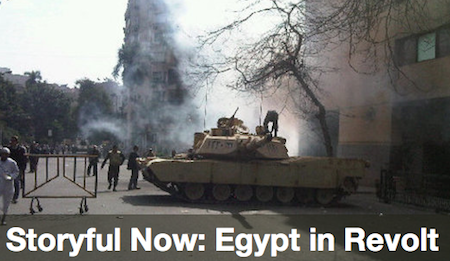
The turmoil in Egypt has shown, yet again, the key role that curation plays in a networked news environment. But as valuable as all the text-based aggregators are — which is to say, hugely valuable — the constantly shifting events on the ground in Egypt make clear how powerful a role video can play in connecting people with the news. You don’t just want to read about or hear about what’s going on; you want to see it. For yourself.
One place you can do that on the web: CitizenTube, YouTube’s news and politics channel. “Raw footage from individuals on the ground offers a visceral window into the situation in Egypt, where crowds are gathering to demand President Mubarak’s resignation,” the channel notes. To present that footage, YouTube has partnered with Storyful, a startup whose goal is to curate the real-time web, to do the important work of filtration.
“It was an invitation that came up in the last week or so,” David Clinch, Storyful’s co-founder and editorial director, told me. Storyful had been curating Egypt video already — not just since January 25, he says, but since the bombing of a Coptic church in Alexandria that took place over New Year’s. YouTube “reached out to us, and said, ‘Look, you guys are the experts, so let’s work together on this.'”
It’s a fascinating experiment. YouTube, after all, for all its obvious benefits, can be difficult to use for a news experience: Videos can be hard to find, they’re not vetted for origin or author, they often lack context, etc. Channels like CitizenTube have tried to provide a solution to those problems — but, to be effective, they generally require some kind of editorial mechanism to bring order to all the tumult. “If you’ve found videos on YouTube that document what’s happening on the streets of Egypt’s cities, please add the links here,” the channel says, making explicit YouTube’s implicit invitation to submit user-generated videos. But, after that invitation’s offered, for an editorial product like CitizenTube, someone needs to sort through the invite’s responses. Someone needs to do the crucial work of curation.
That’s where Storyful comes in. Both Clinch and his Storyful co-founder, Mark Little, are seasoned journalists — both of them, Clinch says, “amazingly, voluntarily, left secure jobs at news companies” to start Storyful. And it’s telling that their experience spans both broadcast journalism and new media. Storyful is in some sense a combination of both. It uses “a proprietary system” that, Clinch says, “is constantly tracking across every platform”: from the biggies of social networking — Facebook, Twitter, YouTube — on down.
The idea is to glean an on-the-ground perspective on the news by harnessing the information pinging around on worldwide social networks. Storyful is, as they say, “a good listener.” It tries to know what the big stories are before they become, in the media-coverage sense, Big Stories. A big part of the value it offers is in anticipating, in fact, what the next big story will be. (Storyful is in that sense somewhat similar to Sulia, the Twitter lists-based curation service I wrote about earlier this week, which essentially practices preemptive curation by crawling Twitter for authorities on topics even before they bubble up to the media more broadly.)
Storyful’s partnership with CitizenTube is very much an experiment, Clinch emphasizes, rather than an ongoing collaboration. (CitizenTube seconds that: As a YouTube spokeswoman emphasized in an email, “We’re experimenting with Storyful on curating YouTube videos to improve discovery of Egyptian protest content for our users.”) But that makes the team-up, to some extent, even more meaningful than a more ongoing partnership might be. The Storyful/YouTube collaboration is a marriage of convenience — in the best sense. It didn’t require a lot of legal haggling or back-room dealing. It simply required an invitation and an acceptance, with no further commitment necessary. We talk a lot about the “shifting public,” the interest group that, on the web, can dissolve as quickly as it comes together. Those dynamic confederacies, in their efficiency, can be powerful. And equally powerful can be collaborations that come together to serve a purpose, content to be nothing more — and nothing less — than experiments.